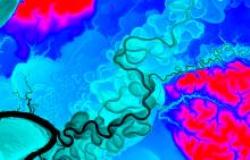Apr 24 2015
Carnegie Science announces the launch of the Carnegie Airborne Observatory-3 (CAO-3), the most scientifically advanced aircraft-based mapping and data analytics system in civil aviation today. “The future of ecosystem research takes off,” remarked principal investigator Greg Asner of Carnegie’s Department of Global Ecology.
 This LiDAR image from the CAO shows the Tambopata River in the Peruvian Amazon. The ancient meanders and oxbows are in blue extending out from the existing river in black. Higher terraced regions are in pink. Image courtesy Greg Asner, The Carnegie Airborne Observatory
This LiDAR image from the CAO shows the Tambopata River in the Peruvian Amazon. The ancient meanders and oxbows are in blue extending out from the existing river in black. Higher terraced regions are in pink. Image courtesy Greg Asner, The Carnegie Airborne Observatory
This third-generation aircraft has been completely overhauled from previous models, boasting a multitude of cutting-edge improvements to its onboard laboratory. Until 2014, the CAO was leased. Now, CAO-3 is owned and operated by Carnegie to increase the flexibility over operational decisions. The new laboratory is now 40% lighter, and features a radically updated sensor package with expanded computing, data collection, and image processing capabilities. Additional improvements include advancements to its satellite and ground communications, and upgrades to the engines and avionics. The plane also features a state-of-the-art “guest investigator” port, allowing new technologies to be flown in concert with the current CAO imaging spectrometer and dual-laser scanning system.
For Asner, these enhancements are nothing less than game changing. “Improvements to the new plane and instrumentation mean that more flights can be made and that our Earth science and conservation initiatives can take advantage of them.” The new plane, with its new look, will be able to fly farther than ever before and operate over higher-altitude regions. It will reach twice the number of ecosystems a day, in regions never accessed until now. CAO’s ability to gather global data is expected to make a huge impact on climate change research. Additionally, the data gathered from these flights will expand on other research topics including animal habitats, carbon stock quantification, rainforest biodiversity, and land use changes and degradation.
These future expectations for the CAO are firmly rooted in its past achievements. Previous generations made remarkable contributions to conservation, sustainable resource use, and environmental policy around the world. It facilitated pioneering research of tropical forest health, and often far exceeding its missions such by detecting illegal gold mining in the Amazon, capturing surprising lion behavior in African savannas, and uncovering archeological sites in Hawaii.
“We have an exciting wish-list of new project targets including the world’s first 3-D animal mapping, and new photosynthesis maps using a new technologies being undertaken by our partners,” says Asner. Asner’s team also plans to map in 3-D the highly diverse forests throughout the world, including the mountains of the Ecuadorean Andes and in the “Heart of Borneo” in Malaysia-Indonesia. By measuring and monitoring the vertical tree-line movement for montane forests, the team hopes to answer long-standing questions about how climate change is affecting forest growth patterns. This critically important issue can now be addressed with CAO-3.
Lastly, CAO data produces stunning, full-color, 3-D imagery, provided free to thousands of organizations in science, art, education—even music and fashion. The possibilities are endless.
How The CAO Works
Carnegie Airborne Observatory-3 is equipped with two powerful and unique tools: the airborne laboratory and the Airborne Taxonomic Mapping System (AToMS). AToMS has state-of-the-art imaging spectrometers and laser scanning (LiDAR) instrumentation. The LiDAR creates 3-D images of the ecosystems it flies over by directing laser pulses downward that then reflect back to an onboard sensor. This information is coupled with data from two spectrometers within AToMS, including the world’s first very high fidelity Visible-Shortwave Infrared Imaging Spectrometer (VSWIR). The VSWIR collects reflected light and breaks it into its spectral components, which are then used to measure various aspects of Earth’s environment, such as vegetation chemistry. The system provides the world's most advanced measurements of ecosystem structure, biomass, and biodiversity.